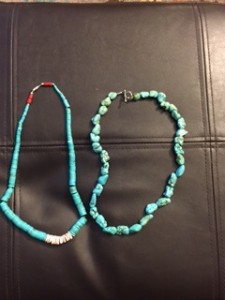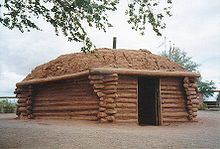In the Navajo culture, the Chindi is a prominent—and feared—figure. “Chindi” is the Navajo word for “ghost,” and this one is no Casper, not by a longshot.
GHOST SICKNESS
The traditional Navajo belief is that a person’s Chindi is released when his or her final breath is taken. The Chindi contains all of that person’s accumulated sins of a lifetime. If the decedent is allowed to pass on outdoors, the Chindi will eventually fade away on its own. It usually takes the shape of a dust devil. If it spins clockwise, that’s a good thing; counterclockwise, not so much. This indicates that the Chindi contained much evil.
On the other hand, if a person dies inside a home or a hogan (traditional Navajo lodge), this is a bad thing. The Chindi now occupies the dwelling, which must either be abandoned and destroyed, or ritually cleansed.

Turquoise is often used as a talisman to protect against the Chindi.
Some believe that a Chindi can be used by Navajo witches or medicine men to inflict “ghost sickness” upon others. By planting a piece of the corpse, or powder from the corpse’s bone, on a person’s body, they can cause fever, exhaustion, or a feeling of being suffocated, even of drowning.
To keep a Chindi at bay, traditional Navajo used “ghost beads,” made from hollowed-out cedar berries and formed into necklaces and bracelets. Turquoise was also used as a talisman, often in combination with the ghost beads.
A DARK FAMILY HISTORY
In the early 1900s a writer came across a teenaged girl named Alice Long Salt. Her family, she told him, was all but gone. Years earlier, she said, two members of the family deceived a blind medicine man, who then sent a Chindi to bring harm upon them. Over time each member of the family became seriously ill and eventually died.
The same fate awaited those who married into the Long Salt clan. When Alice was seven, her mother died. Her father wasted away over two years and finally perished. Three remaining members of the family, aside from Alice, also became debilitated and ultimately died.
Three years after talking to the writer, Alice Long Salt was found dead.

A traditional Navajo hogan.
Perhaps poor Alice would have benefited from an Enemy Way. This is a traditional Navajo ceremonial used to counter the effects of a Chindi. The three-day ceremonial, which includes dance, sand painting, and ritual chanting, involves the summoning of Monster Slayer, a powerful figure in Navajo mythology. A good description of the Enemy Way—as well as a juicy murder mystery—can be found in Tony Hillerman’s novel, The Blessing Way.
Many cultures have their own ghosts and spirits. For the Diné (Navajo), the Chindi continues to be one scary entity.

The Roger Zelazny novel, Eye Of Cat, makes excellent use of this belief.
Indeed! Thanks for mentioning it.
I heard amulets made of black obsidian will ward of the Chindi, is this true?
Michael, black obsidian is a protective stone that shields against all negative energy from one’s surroundings. So yes, it can certainly ward off a Chindi. Thanks for checking out my blog.
Do you believe a chindi can attach to a person if they were with a dying navajo?
Laura, I wouldn’t think so…but I’m an old biligaana, so what do I know? 🙂 Seriously, perhaps checking out some Navajo websites might enable you to ask that question of a historian or mythologist. Good luck.